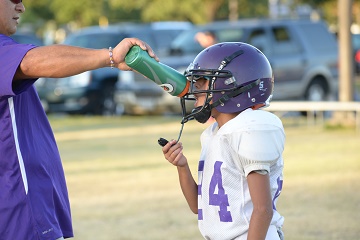Lead them to water but do make them drink
Summertime is here, along with advice to drink plenty of water and remain well-hydrated. While maintaining hydration is important, this well-intentioned advice can be overdone, especially in weekend warriors and motivated athletes, resulting in sodium disorders like exercise associated hyponatremia. (1) Millions of youth, high school, college, and adult athletes will take to the playing fields and roads to train and compete this summer in the USA (2-5), which should elevate our clinical suspicion for disorders of fluid balance as well as heat illness.
Extreme heat (daily temperatures >99th percentile) significantly increases the relative risk for both fluid and electrolyte disorders and heat stroke in older resting individuals. (6) In physically active individuals, exercise augments thermoregulatory strain in the heat; especially in those who are not acclimatized. The need for individualized fluid replacement strategies - to compensate for potentially large sweat water and electrolyte losses - is therefore critical for both performance and health. And while the perils of dehydration have been widely disseminated by sporting organizations, (7) the more dire consequences of overhydration have not been fully recognized. (8)

Symptomatic and potentially life-threatening hyponatremia occurs in ≤1% of endurance athletes. (9) The incidence of asymptomatic hyponatremia has recently been reported to be as high as 70% in 30 elite German rowers tested during a 28-day training camp. (10) With the large number of people training in the US, it is possible that an athlete may present to a clinic and hospital with symptomatic or asymptomatic hyponatremia, which would put them at increased risk for morbidity and mortality if the diagnosis of hyponatremia is missed, hydration advice is misguided, or treatment is inappropriate.
So, as summer swelters on, those on the front line of athletic care should be especially vigilant of hyponatremia when treating sick patients or advising healthy individuals. Recommend having a variety of fluids freely available and advise people - especially exercising athletes - to drink when thirsty and reduce activity, splash with water, and seek a shaded spot when hot. Proper hydration is a physiologically-mediated behavioral drive which can be consciously overridden by inappropriate advice. Thus, before we promote blanket advice to "drink lots of fluid" and "stay well-hydrated", we should be mindful that fluid is a balance - especially during exercise.
Tamara "Tami" Hew Butler is an Associate Professor of Exercise Science at Oakland University in Rochester, Michigan, and a member of the MomsTEAM Institute Board of Advisors and of its Heat Injury Working Group.
References:
1. Braun MM, Barstow CH, Pyzocha NJ. Diagnosis and management of sodium disorders: hyponatremia and hypernatremia. Am Fam Physician 2015; 91(5):299-307.
2. National Federation of State High School Associations (NFHS). High School Participation Increases for 25th Consecutive Year. 10-30-2015. http://www.nfhs.org/articles/high-school-participation-increases-for-25t..., www.nfhs.org.
3. Johnson G. Athletics participation rates continue to rise. 10-15-2015. http://www.ncaa.org/about/resources/media-center/news/athletics-particip..., www.ncaa.org. 6-18-2015.
4. Wood R. USA Running's Marathon Report 2014. 5-5-2015. http://running.competitor.com/2015/05/news/running-usa-unveils-interesti..., competitor.com. 6-18-2015.
5. Buteau M. Ironman Adds Gatorade Sponsorship in Triathlon Agreement. 10-10-2014. http://www.bloomberg.com/news/articles/2014-09-10/ironman-adds-gatorade-..., bloomberg business. 6-18-2015.
6. Bobb JF, et al. Cause-specific risk of hospital admission related to extreme heat in older adults. JAMA 2014; 312(24):2659-2667.
7. Sawka MN, et al. American College of Sports Medicine position stand. Exercise and fluid replacement. Med Sci Sports Exerc 2007; 39(2):377-390.
8. Hew-Butler T, et al. Statement of the Third International Exercise-Associated Hyponatremia Consensus Development Conference, Carlsbad, CA, 2015. Clin J Sport Med 2015;25(4):303-320.
9. Noakes TD, et al. Three independent biological mechanisms cause exercise-associated hyponatremia: evidence from 2,135 weighed competitive athletic performances. Proc Natl Acad Sci U S A 2005;102(51):18550-18555.
10. Mayer CU, et al. High Incidence of Hyponatremia in Rowers during a Four-Week Training Camp. Am J Med 2015;128(10):1144-51. (Epub ahead of print).
First published July 19, 2017








